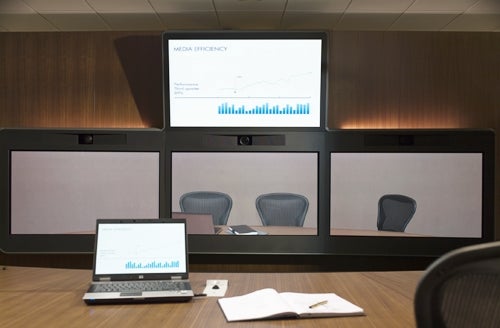Working In A Virtual World
If there’s anything this winter has taught us, it’s been the value of broadband access in our homes.
It was only a few years ago when a day at home because of a bad snowstorm pretty much meant that I got nothing done. Those were the days when I had dial-up Internet access. Remember that? Remember that funny noise the modem would make as you attempted to connect?
Interestingly, dial-up isn’t as much of a dinosaur as we might assume. According to AOL’s most recent report, there are still 5 million Americans who subscribe to the company’s dial-up service. Amazing, right?
Staying Productive
For those of us who aren’t paying AOL $25.90 per month to check our e-mail, we likely benefit from pretty high-speed connections to the Internet, which makes working from home a snap. I can write and file stories from home, chat with colleagues, edit pages and update our website — all without leaving the worn grooves of my living room couch.
But what I haven’t tried yet, but I’m hopeful to try someday soon, is video chatting. I’ve used Skype, the free online calling service, to video chat with friends and family around the holidays, but it’s only a matter of time before I start using video chat in the office. And I really can’t wait for the day when high-definition video conferencing becomes the norm in most offices.
One of the benefits of being a reporter (and trust me there are few) is getting to call up companies and say, “Hey, I want to learn more about X and share that with my readers.” I decided to pull that card recently with HP so I could check out the immersive video conferencing system known as HP Halo.
The local HP Halo product team used to be based in Marlborough, but moved operations to Andover last fall. In Andover, Marcio Macedo, director of product development for HP visual collaboration, took me through a demo of the technology, which includes three 65-inch screens and three cameras. To get a real sense of how it worked, we conferenced with Karin Taylor, a manager of media and analyst relations for HP, at the company’s Cupertino, Calif., office.
Marcio and I sat at a half-moon table with six chairs around it. In front of us were the three high-definition screens. Taylor, in California, appeared on one of the screens and because most HP Halo rooms are styled nearly identical, it felt as if we were sitting across the table from her. Taylor appeared life size and there was absolutely no hesitation in the video quality or audio during my demo. It was as real as a face-to-face conversation.
Making Eye Contact
The HP Halo rooms and cameras are set up specifically to capture the nuances of how we interact. You can tell whether someone is looking directly at you, or glancing to their neighbor for help with an answer. If you’ve got multiple rooms connected for a call, say one in California, one in Massachusetts and one in Beijing, the cameras capture “gaze angles,” so if someone in China is answering a question from Massachusetts, they’ll appear to all participants to be looking at the Massachusetts screen. That sounds basic, but if you really think about it, that kind of nuance takes some pretty fancy geometry.
The HP Halo video conferencing rooms were launched in 2006, around the same time that Cisco launched its similar product, Cisco Telepresence. HP began marketing the product to executives with global operations, so that CEOs could cut down on travel budgets and still “meet” with far-flung counterparts around the globe. Over time, they’ve begun installing the systems for companies that want to use the technology for conferencing among teams. For example, HP’s own ink-jet cartridge group started using HP Halo to conference with staff in Singapore and managed to get products to market six months faster.
Of course, this type of technology is only available to large companies looking to shell out some serious bucks. But I’m convinced that the technology is only going to get cheaper and services like Skype are only going to get better.
In fact, HP is now extending its video conferencing technology to desktop computers, which means you won’t need to have one of the specially designed rooms with the big screen TVs to participate in a video conference.
In five or 10 years, video conferencing from our desktops is going to be the norm, and I for one can’t wait. I just don’t know how much I want the boss to see me in my pajamas on a snow day. I guess that’s a small price to pay for convenience.
Now, where did I leave my slippers?
Got news for our Digital Diva column? E-mail Christina H. Davis at cdavis@wbjournal.com.











0 Comments